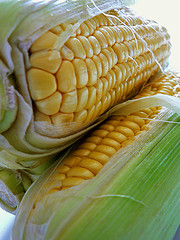Sweetcorn
| Infobox on Sweetcorn | |
|---|---|
| Example of Sweetcorn |  |
| Freshness facts | |
| Optimum carrying temperature | 0°C to 1°C |
| Highest freezing point | -0,6°C |
| Acceptable product temp. at loading into containers | Max. 2°C above carrying temperature |
| Optimum humidity | 95% to 100% |
| Ventilation setting for containers | 10 m³/hr |
| Storage life | 1 week |
| Climacteric / non-climacteric | Non-climacteric |
| Ethylene production | Very low |
| Ethylene sensitivity | Low |
| Modified / controlled atmosphere | See text |
| Potential benefits | See text |
| Availability | |
| On demand | |
Sweetcorn
Contents
Harvesting and Handling
Sweetcorn postharvest expectations have changed dramatically with the increased availability and popularity of super sweet varieties based on the shrunken-2 gene (sh-2) and other naturally-occurring sweetness enhancing mutations. Although there is no relation to sweetness, regional consumer perceptions and preferences for kernel colour have also caused significant shifts from traditional yellow corn to white and bicolour corn.
Sweetcorn is considered mature for fresh market consumption or "baby kernel" processing when the pollination silks are dried and the kernels are still immature. The husk leaves remain tight and have a good green appearance. The ear is firm and turgid. The kernels are plump and appear 'milky', and not doughy, when squeezed. At this point the kernels of standard 'sugary' corn are 70-75% water content and kernels of sh-2 corn are at 77-78% water content.
Quality of fresh market sweet corn is judged by its fresh, uniform appearance, uniform and well filled rows, plumpness of kernels, milky kernel contents, and freedom from damage and defects (discoloration, harvest injury, worm damage, live insects, decaying silks or kernels). Trimmed, husked, or minimally processed whole -ears (i.e. microwave consumer packs) have additional grade standards for husk cover, husk appearance, length, and other quality indicators.
Fresh-cut sweetcorn kernels are extremely perishable. Their respiration rate is very high; several times that of intact ears. Thus, temperature control is extremely critical if the kernels are to have acceptable shelf-life. Problems during handling can include off-flavours, microbial survival/growth, and discolouration if the temperature is not maintained near 0°C. Especially troublesome is browning when the kernels are cooked. This browning is greater in kernels from more mature ears and is correlated with temperature, storage duration, and extent of physical damage.
Cooling and Storage
Rapid removal of field heat and continuous and proper refrigeration are essential to the maintenance of sweetcorn quality.
Traditional sweetcorn varieties are seldom stored for more than a few days, because of the resulting serious deterioration and loss of tenderness and sweetness. The loss of sugar is about 4-fold as rapid at 10°C as at 0°C. At 30°C, 60% of the sugar in sweet corn can be converted to starch in a single day, while only 6% is converted at 0°C. Sweet corn is not chilling sensitive; store as cold as possible without freezing. Freezing injury will be initiated at – 0,6°C. Symptoms of freezing injury include watersoaked patches on the husks and watersoaked kernels becoming gelatinous and developing off-odours over time.
Controlled atmosphere considerations
Reduced O2 and elevated CO2 reduce respiration and slow sucrose loss; elevated CO2 also reduces decay and maintains green husk colour. Injurious atmospheres at 1,7°C contain <2% O2 or >15% CO2, resulting in fermentation, off-flavours and odours.
Storage disorders
Bacterial rots, Barley yellow dwarf virus, Chilling injury, Fusarium, Maize dwarf mosaic virus, Off odours, Rust, Smut.











